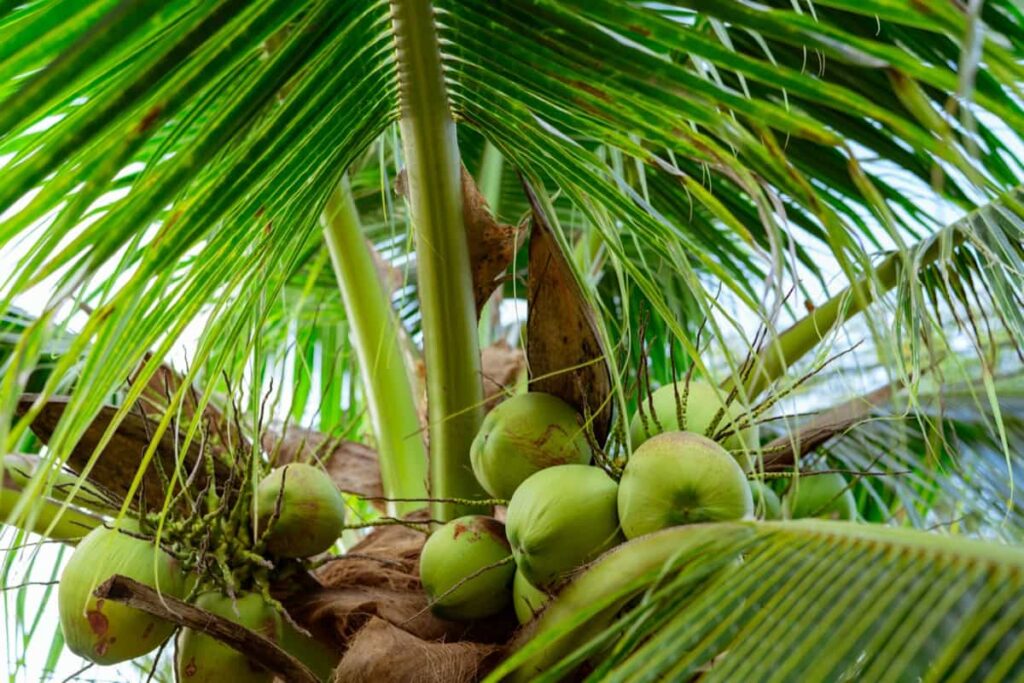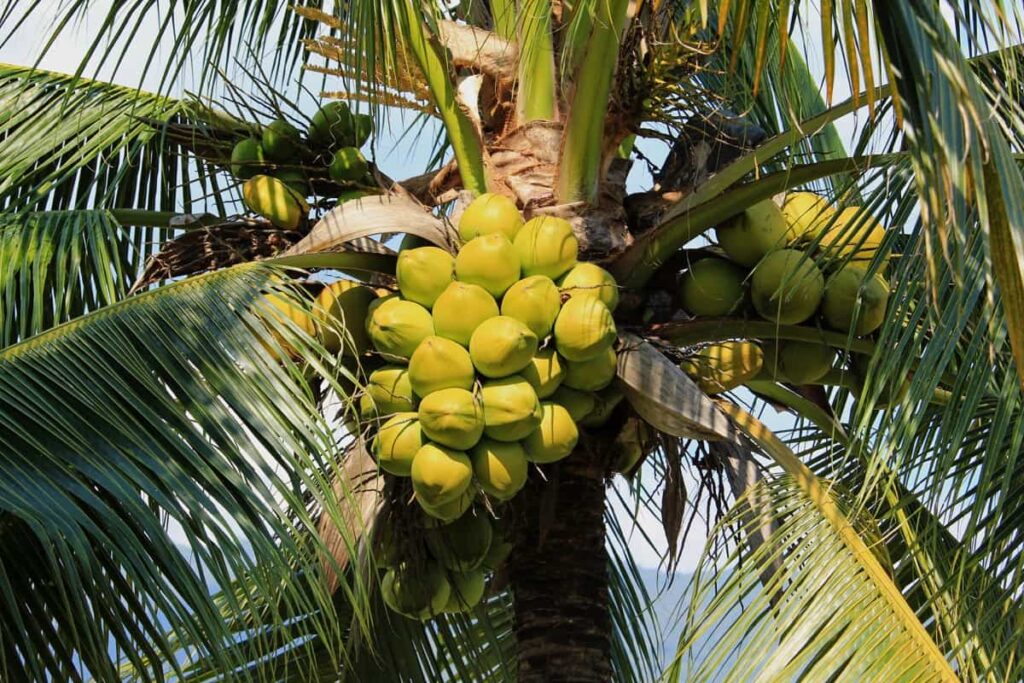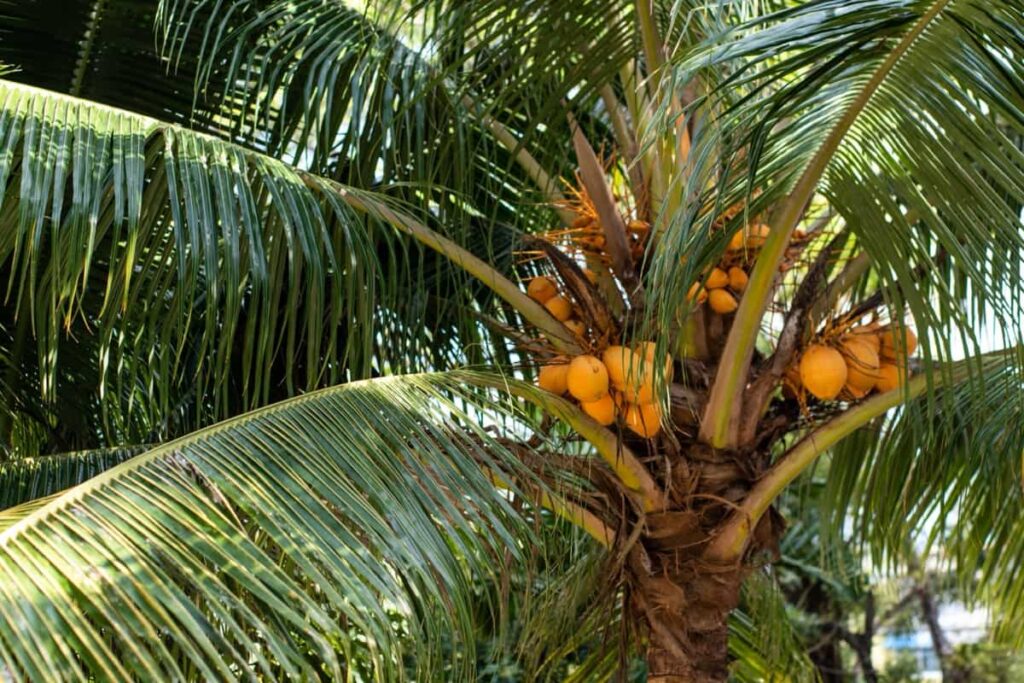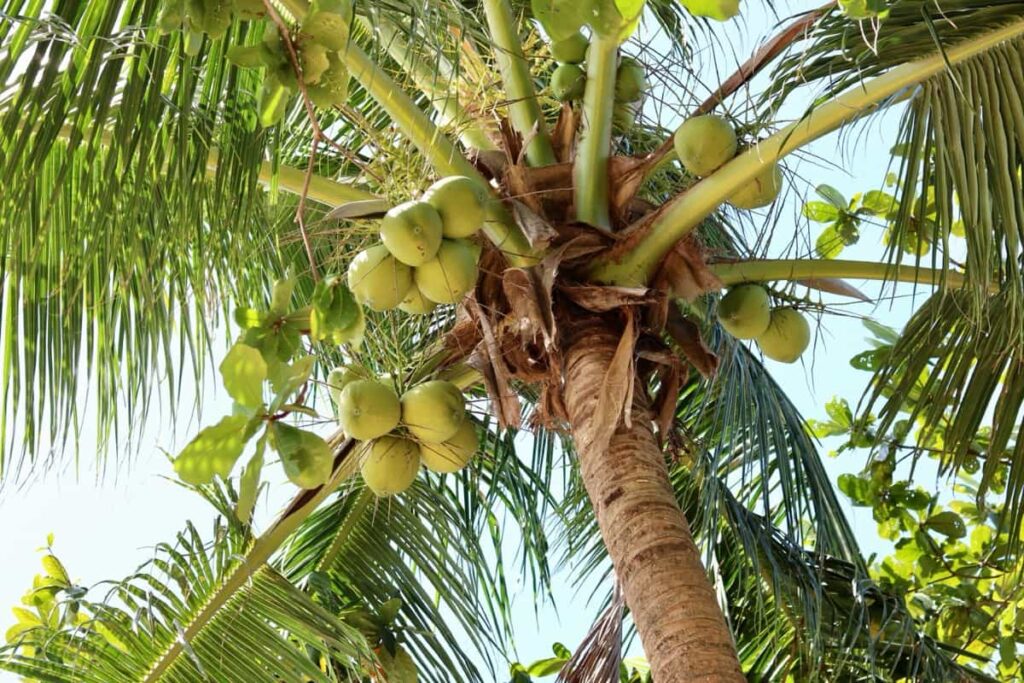Coconut flower drop can result from various factors, including adverse weather conditions such as excessive rainfall, drought, or extreme temperatures, nutrient deficiencies, pests like coconut mites or rhinoceros beetles, diseases like bud rot or root wilt, improper cultural practices, and genetic factors.

How to Stop Coconut Flower Drop
Impact on Coconut Production and Yield
Coconut flower drop significantly reduces the yield potential of coconut trees. Without sufficient flowers, there are fewer fruits formed, leading to decreased production. This ultimately affects coconut farmers’ income and livelihoods, as well as the supply of coconuts for various industries like food, cosmetics, and pharmaceuticals. Additionally, it can disrupt the local economy and food security in coconut-growing regions.
Optimal Watering Practices
Watering Techniques for Healthy Coconut Trees
For water management to prevent flower drop, apply water directly to the soil around the base of the tree rather than overhead. Ideally, water should penetrate at least 1 to 2 feet into the soil. Use a slow watering technique to allow absorption without runoff. Coconut trees typically require 1 to 1.5 inches of water per week, adjusting for climate and soil conditions.
Signs of Over and Underwatering
- Overwatering: Yellowing or wilting fronds, waterlogged soil, and fungal growth are signs of overwatering. Roots may rot, leading to stunted growth and decline.
- Underwatering: Wilted or yellowing fronds, dry and cracked soil, and decreased fruit production indicate underwatering. Coconuts may be smaller, and overall growth is stunted.
Nutrient Management Strategies
Essential Nutrients to Prevent Flower Drop
To mitigate Coconut flower drop prevention, along with Nitrogen and Phosphorus, ensure adequate availability of essential nutrients like potassium (K), magnesium (Mg), and boron (B). Potassium plays a crucial role in flower development and fruit set, while magnesium aids in photosynthesis and enzyme activation, promoting overall plant health. Boron is indispensable for pollen tube elongation and fertilization.
Implementing a Balanced Fertilization Program
Effective fertilization for coconut flowers by maintaining the optimal NPK ratio, typically 3:1:6, to support healthy growth and flowering. Fertilizers should be applied evenly around the tree’s drip line, preferably during the rainy season, to aid in nutrient uptake. Application rates may vary depending on soil fertility and tree age, with general recommendations ranging from 1-2 kg of fertilizer per tree per year.
Enhancing Soil Health to Control Flower Drop in Coconuts
Improving Soil Fertility for Coconut Trees
Soil improvement for coconut bloom stability by implementing nutrient-rich organic solutions for coconut flower drop amendments, such as compost or manure, replenishes essential minerals vital for coconut tree growth. Regular soil testing guides precise fertilizer application to address specific nutrient deficiencies, fostering healthier tree development and reducing flower drop.
In case you missed it: Cocoa Farming in Africa: Recent Developments of Cultivation, Production Cost and Profit

Correcting Soil pH for Optimal Growth
As one of the remedies for coconut flower loss, adjusting soil pH to the ideal range of 5.5 to 7.0 through lime application or sulfur amendments optimizes nutrient availability and microbial activity, promoting robust root development and improved nutrient uptake in coconut trees. Balanced soil pH mitigates stressors contributing to flower drop, ensuring consistent coconut production.
Pest and Disease Control: Coconut Tree Pest and Disease Solutions
Identifying and Managing Common Pests
Common pests affecting coconut flower drop include the rhinoceros beetle and the coconut mite. The rhinoceros beetle damages coconut palms by feeding on the sap and causing structural damage, leading to flower drop. Coconut mites infest young coconuts, causing flower abortion and reducing fruit set. Treatment for coconut flower shedding involves regular inspection and removal of infected flowers, as well as the use of biological controls or pesticides specifically targeted to these pests.
Preventive Measures and Treatments for Diseases
To prevent diseases like bud rot and basal stem rot, which contribute to flower drop, maintain good cultural practices such as proper drainage, balanced fertilization, and pruning. Additionally, applying fungicides to protect against fungal pathogens and avoiding injuries to the coconut palm can help mitigate disease incidence. Monitoring coconut trees for flower health and addressing coconut flower drop early through regular monitoring and prompt treatment with appropriate fungicides are crucial for disease management and preserving coconut yield.
Proper Pruning Techniques
Pruning for Improved Air Circulation and Sunlight Exposure
Strategic pruning in coconut trees enhances air circulation and sunlight penetration for optimal growth. Removing crowded or dead fronds fosters better airflow, reducing disease risks and promoting a healthier canopy. These pruning strategies for coconut flower health allow sunlight to reach lower branches, stimulating overall photosynthesis and coconut development.
The Role of Pruning in Reducing Flower Drop
By removing excess or unproductive fronds, the tree allocates more energy towards flower and coconut production. This targeted approach ensures a higher retention of blossoms, leading to increased yields and improved overall productivity.
In case you missed it: Know the Process of Making Coco Peat at Home: Step-by-Step Guide

Ensuring Adequate Pollination to Coconut Flower Drop
Encouraging Natural Pollinators in the Coconut Grove
Implementing habitat preservation and diversification to attract native pollinators like bees, butterflies, and birds. This involves planting flowering plants that provide nectar and pollen, maintaining nesting sites, and minimizing pesticide use to safeguard pollinator populations.
Artificial Pollination Techniques
Enhancing pollination in coconut trees, implement controlled pollination methods like hand pollination using brushes or transferring pollen manually. This ensures consistent pollination even in the absence of sufficient natural pollinators.
Stress Management in Coconut Trees
Identifying and Mitigating Environmental Stressors
Coconut trees face various environmental stressors, including drought, soil salinity, and extreme temperatures. Regular monitoring of soil moisture, proper irrigation techniques, and soil amendment to reduce salinity can mitigate these stressors. Additionally, providing adequate shade and windbreaks can protect trees from harsh sunlight and strong winds, minimizing stress.
Techniques to Reduce Tree Stress for Better Flower Retention
As Coconut tree stress reduction methods, implementing appropriate cultural coconut cultivation best practices such as balanced fertilization, pruning, and pest control can enhance tree health and promote flower retention. Mulching helps in moisture retention and weed suppression, reducing competition for nutrients. Furthermore, maintaining optimal humidity levels through proper irrigation management fosters favorable conditions for flower development, ultimately improving yield and overall tree resilience.
Use of Growth Regulators
The Role of Growth Regulators in Preventing Flower Drop
As Coconut bloom retention techniques, growth regulators are crucial in mitigating coconut flower drop by regulating hormonal balance and enhancing flower retention. These growth regulators for coconut flower preservation, such as cytokinins and gibberellins, stimulate growth and development, bolstering the coconut’s ability to retain flowers.
Application Methods and Timing for Optimal Results
Effective application methods involve foliar spraying or trunk injection during critical growth stages, particularly during the induction and initiation of flowering. Timely application, typically before the onset of the flowering season, ensures maximum absorption and efficacy, safeguarding against flower drop and promoting an abundant fruit set.
In case you missed it: 20 Best Dwarf Coconut Varieties: Hybrid High Yielding Coconut Cultivars

Conclusion
By incorporating these remedies and treatments into your coconut palm management practices, you can effectively mitigate coconut flower drop and promote healthier tree growth and fruit production. Remember to observe and adapt these strategies based on local conditions and specific needs to achieve the best results.
- Profitable Village Farming Business Ideas in 2024
- High-Yield Aquaculture: Fast-Growing Fish for Farming
- Effective Fish Pond Construction Techniques for Beginners
- Irrigation and Water Management in Pineapple Farming
- Blossom to Harvest: Mastering Flowering and Pollination in Papaya Farming
- Pig Fattening Essentials: From Selection to Sale for Beginners
- Raising Wagyu Cattle: A Complete Guide for Premium Beef Production
- Soil Types and Their Water Holding Capacity
- Optimizing Irrigation Schedules for Coconut Groves for Enhanced Yield
